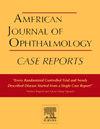Tapetal-like sheen as a key phenotypical feature in TTLL5-associated cone dystrophy caused by a novel variant
Q3 Medicine
引用次数: 0
Abstract
Purpose
To report a patient with cone dystrophy and a striking tapetal reflex caused by a novel variant in TTLL5, which was initially missed by a local retinal specialist due to inaccurate phenotyping of macular dystrophy.
Observation
A 33-year-old male patient presented with Bull's eye maculopathy and a tapetal-like reflex, confirmed via fundus examination and multimodal imaging. Initial genetic testing with a macular dystrophy panel was negative. Electroretinography showed reduced photopic responses and normal scotopic responses, supporting a diagnosis of cone dystrophy, and subsequent evaluation using an extended inherited retinal dystrophy panel identified a homozygous TTLL5 c.1186+2T>C variant classified as “likely pathogenic.”
Conclusions and importance
This case underscores the critical role of accurate phenotyping in guiding molecular genetic testing, particularly in distinguishing cone dystrophy from other macular dystrophies, and highlights the unique expertise of inherited retinal disease specialists in this process. Additionally, it further validates the possibility that the tapetal reflex is a common but previously underrecognized feature of TTLL5-associated retinal dystrophies and expands the known variant spectrum of TTLL5-associated disease. The presence of a tapetal reflex—previously widely associated with RPGR-associated dystrophies—highlighting the overlapping disease mechanisms and clinical presentation.
毡层状光泽是由一种新变异引起的ttll5相关锥体营养不良的关键表型特征
目的报告一例由TTLL5基因突变引起的锥体营养不良和显著的毡层反射的患者,由于黄斑营养不良的表型不准确,最初被当地的视网膜专家遗漏。患者男,33岁,表现为牛眼黄斑病变,经眼底检查和多模态成像证实为绒毡样反射。最初的黄斑营养不良基因检测结果为阴性。视网膜电图显示光性反应减少,暗性反应正常,支持锥体营养不良的诊断,随后使用扩展的遗传性视网膜营养不良小组进行评估,确定了纯合的TTLL5 C .1186+2T>;C变异,分类为“可能致病”。结论和重要性本病例强调了准确的表型在指导分子基因检测中的关键作用,特别是在区分锥体营养不良症和其他黄斑营养不良症方面,并突出了遗传性视网膜疾病专家在这一过程中的独特专业知识。此外,它进一步证实了毡层反射是ttll5相关视网膜营养不良症的一种常见但以前未被认识的特征的可能性,并扩大了ttll5相关疾病的已知变异谱。绒毡层反射的存在-以前广泛与rpcr相关的营养不良相关-强调了重叠的疾病机制和临床表现。
本文章由计算机程序翻译,如有差异,请以英文原文为准。
求助全文
约1分钟内获得全文
求助全文
来源期刊

American Journal of Ophthalmology Case Reports
Medicine-Ophthalmology
CiteScore
2.40
自引率
0.00%
发文量
513
审稿时长
16 weeks
期刊介绍:
The American Journal of Ophthalmology Case Reports is a peer-reviewed, scientific publication that welcomes the submission of original, previously unpublished case report manuscripts directed to ophthalmologists and visual science specialists. The cases shall be challenging and stimulating but shall also be presented in an educational format to engage the readers as if they are working alongside with the caring clinician scientists to manage the patients. Submissions shall be clear, concise, and well-documented reports. Brief reports and case series submissions on specific themes are also very welcome.
 求助内容:
求助内容: 应助结果提醒方式:
应助结果提醒方式:


